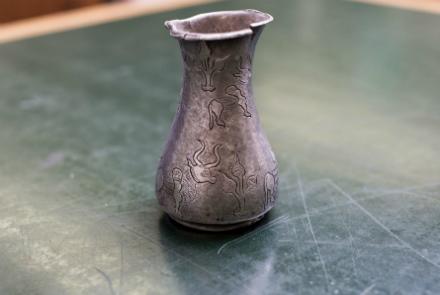An ancient silver flask seized at Gatwick Airport in London has been unveiled for the first time, ahead of its return to Afghanistan, according to The SundayTelegraph.
Photographed exclusively for the Telegraph, it is believed to be the first time it has been seen by the public since it was created more than 4,000 years ago.
The treasure has come to light only because it was dug up illegally in Afghanistan and smuggled to Britain.
The British Museum realised it’s significance as soon as it was brought to them and has kept it safely in storage since its seizure at Gatwick Airport. It is now planning an official hand-over to the National Museum of Afghanistan in Kabul this autumn.
Dr St John Simpson, a senior curator at the British Museum, told the Sunday Telegraph that this is a “spectacular” museum-quality object.
It dates from between about 2,300 and 2,000 BC when Afghanistan was closely connected by trade with the neighbouring Bronze Age civilisations in the Indus valley (Pakistan), eastern Iran and southwest Central Asia.
“Very few other vessels of precious metals survive from that date from Afghanistan or the surrounding countries. What normally happened in antiquity is that precious metal was recycled and melted down,” Simpson said.
He pointed to its beautiful engraved design, featuring intricate depictions of humped bulls inlaid with traces of gold sheet set into deeply cut lines.
Speculating on who might have owned it in 2,000BC, he said: “Silver has always been the most desirable metal of antiquity. So you’re dealing with a member of the elite, female or male.”
The flask is 12.3 cm high. Possibly a drinking vessel, it could hold the equivalent of about two average glasses of wine.
“It’s a new type. We didn’t have a precious metal vessel of this shape before. It’s in very good condition. We’ve checked the authenticity by analysing the silver, [which] is very high purity with no modern additions,” Simpson added.
The British Museum held on to the flask while security forces waited to see whether anyone tried to claim the piece. No arrests have been made.
Its return to Kabul is particularly significant. About 75 percent of the museum’s antiquities have been destroyed or looted. They reflected the rich heritage of a land that was once a crossroads of eastern and western ancient civilisations.
Afghanistan continues to be blighted by deadly violence. But, since the civil war period of the 1990s, the museum has been restored and is open to the public. Simpson said that it is secure and “quite heavily visited”, particularly by Afghan school groups and families.
The British Museum sees this case as another significant milestone in the identification and return of stolen cultural heritage. Working closely with the police, the UK Border Force and other agencies, it has helped to recover thousands of looted antiquities from Afghanistan alone since 2003.

